

ECMWF Director of Research Andy Brown opened the Annual Seminar 2022.
In ECMWF’s first in-person Annual Seminar in three years, over 100 scientists and students came together from 12 to 16 September to look at the large range of physical processes and scales that have to be represented in seamless weather prediction. The seminar was also followed daily by over 50 attendees on the livestream.
Participants came from South Korea, Uzbekistan, Georgia, the US and many other countries. They were generally enthusiastic about the quality of the seminar and the opportunity to meet in person. Comments ranged from “such a dynamic, intense and refreshing seminar” to “it is not often I have been to a meeting where everything is interesting and high quality”.
“The aim was to cover all physical processes in terms of mathematical formulation, available observations, data assimilation and corresponding uncertainties in current and future high-resolution forecast systems,” ECMWF scientist Peter Bechtold explains.
ECMWF Director of Research Andy Brown opened the seminar, which comprised ten sessions with 43 oral presentations. Fifteen posters could be viewed in the early afternoons, and there was ample time for personal discussions.
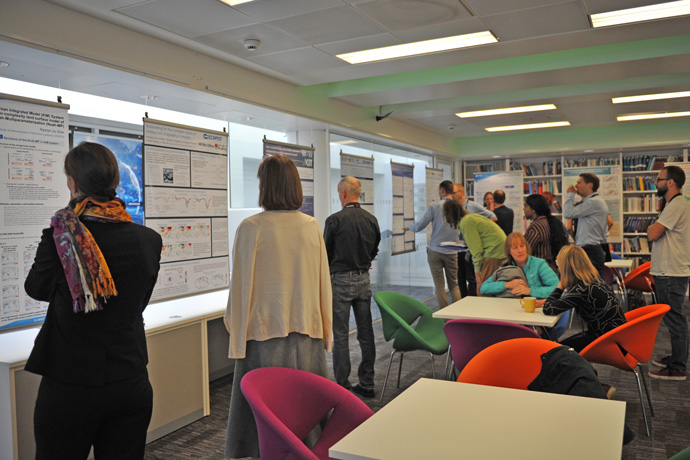
Poster sessions took place in between the Annual Seminar presentations.
Here we present some highlights from the presentations.
Atmospheric turbulence
A central theme of the turbulence session was how to represent and validate atmospheric turbulence in more general terms. This included cloudy conditions, cloud-resolving and eddy-resolving resolutions, and complex orography or heterogenous surfaces.
Experimental numerical approaches include higher-order prognostic turbulence formulations, as well as taking into account horizontal turbulent exchanges and revised stability functions for the stable regime.
It was noted that representing upgradient convective momentum transport with a turbulence scheme and a shallow convection scheme remains a challenge over subtropical oceans.
Air–sea interaction
Air–sea interaction concerns the turbulent fluxes at the ocean surface that are driven by atmospheric winds, ocean waves and ocean currents.
The strong effect of heat and momentum exchanges on atmospheric convection and sea-surface temperature drifts in forecast models was illustrated. Particular attention was paid to the effect of wave drag in high wind conditions, such as tropical cyclones.
New formulations for the effect of ocean wave drag and sea spray, involving bursting air bubbles, were presented.
Convection and global km-scale models
This session covered advances in parametrizing convection in global models; lightning; model validation of convective systems and tropical waves; and the transition to convection-permitting resolutions in the 1–4 km range. These themes were also covered by several posters.
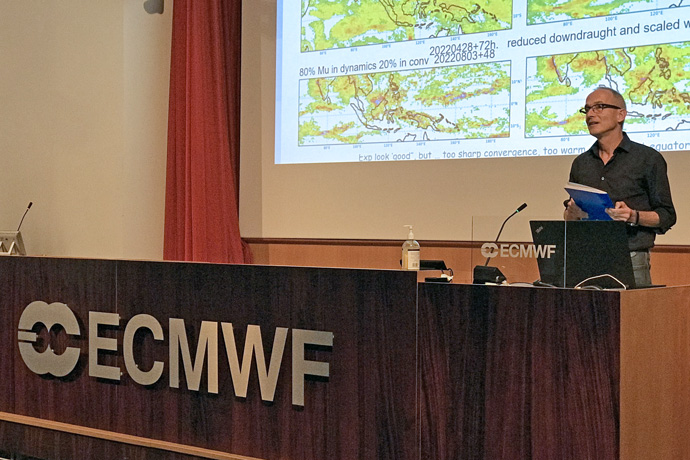
Peter Bechtold gave a presentation on ‘aspects and structures seen with the IFS convection parametrization and efforts towards 1–4 km resolutions’.
It was shown that parametrizations have evolved significantly in the last 35 years. They now reasonably represent convective organisation and large-scale tropical waves. However, coupling with dynamics, resulting sometimes in spurious convectively generated gravity waves, could be improved, as could convective memory and exchange with neighbouring grid columns.

Daniel Klocke from the Max Planck Institute for Meteorology gave a talk on ‘km-scale climate simulations’.
Further lessons from global km-scale models were that tropical cyclones and medicanes are reasonably reproduced at 4 km resolution; extremes such as wind gusts and high-intensity precipitation benefit from higher resolution; and 1 km horizontal resolution is necessary to resolve ocean eddies.
Physics–dynamics interface and gravity waves
Global wave spectra and modes were presented, computed from km-scale global model output. The aim was to demonstrate the impact of the physical processes of convection and diffusion.
Looking at the gravity wave spectrum in the stratosphere, it appears that a realistic gravity wave spectrum can be obtained at 1 km resolution simulations. At resolutions of 4 km and lower, on the other hand, the scales of stratospheric gravity waves are significantly overestimated.
Microphysics and clouds
Microphysics concerns processes from the micro-scale, such as autoconversion, size distribution and evaporation, to the cloud scale. The developments discussed include aerosol processes, cloud–radiation interaction effects, and the development of a double moment scheme that helps to reduce too intense rainfall in a convection-permitting model.
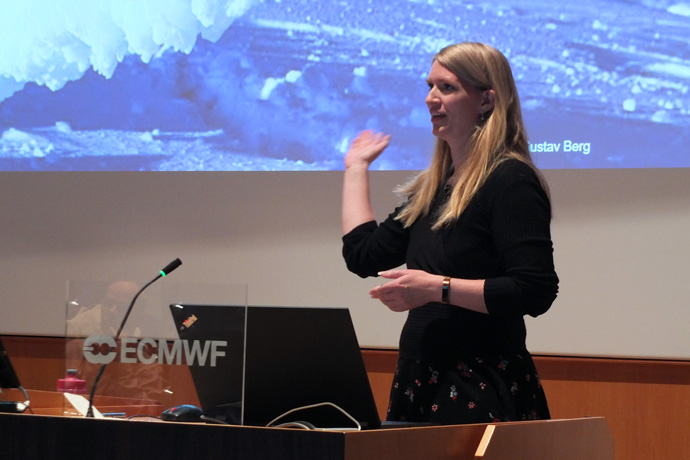
Jenny Engdahl from the Norwegian Meteorological Institute gave a presentation on improving the representation of supercooled liquid water in the HARMONIE-AROME model.
On the climatological side, the influence of microphysics on mid-tropospheric relative humidity in the tropics was discussed, and on the application side, the icing threat by supercooled liquid water on aircraft and power cables was presented.
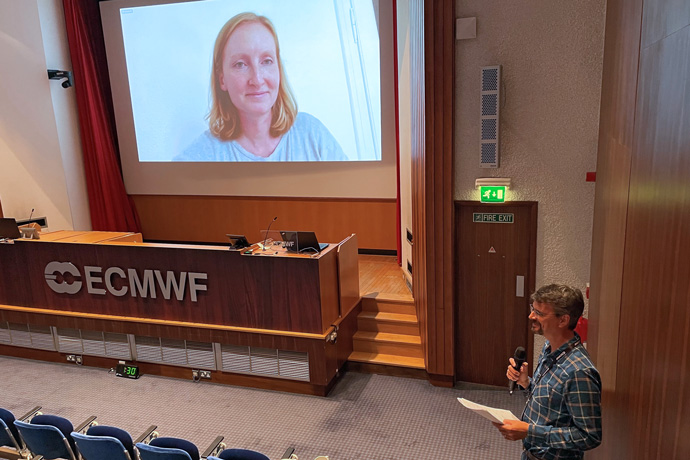
Ann Kristin Naumann from the Max Planck Institute for Meteorology gave a remote presentation on ‘microphysical controls on humidity, radiation and the tropical energy budget in global storm-resolving models’.
Radiation
Radiation computations can be uncertain due to uncertain input (notably clouds, albedo, aerosols, ozone) and due to inaccuracies in the computations. Several novel approaches were discussed, such as a 4-stream (compared to 2-stream) computation of radiative fluxes, computing three-dimensional radiative effects in the short- and longwave, and using a single-band approach.
Machine learning algorithms have been shown to be well suited for these potentially more complex and numerically expensive radiation schemes. Advances in radiation also call for new spectrally resolved radiation observations from hyperspectral satellite measurements.
Land surface and orographic drag
The impressive evolution of land surface schemes in recent years was presented. They have moved from simple surface energy balance schemes to multi-layer schemes for soils and snow, with a thin top layer of up to 1 cm. They have also been coupled to a sea ice model, surface hydrology, interactive vegetation and urban environments.
New surface physiography datasets provide unprecedented resolution, and new satellite data allow for the assimilation of soil moisture and leaf area index. The current tile approach is assumed to be suitable down to 1 km resolution. New results are coming up on how increased forest cover and groundwater availability can modulate heat waves.
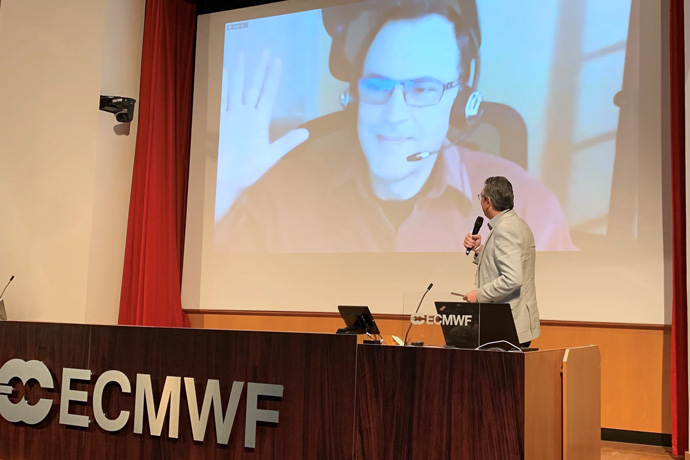
Ayrton Zadra from Environment and Climate Change Canada (ECCC) gave a remote presentation on ‘challenges representing orographic drag in (Canadian) numerical prediction systems’.
For orographic drag, the aim is to have an optimal partition between resolved orographic drag and the subgrid contribution, made up of subgrid orographic drag and turbulent orographic form drag.
Optimal filtering of the assumed resolved model orography is important for predicting orographic flow. The impact of orographic drag is globally most dominant over the Himalayas during boreal winter, and models still struggle to have an optimal setup at resolutions of 4 km and higher.
25 years of linear physics
This was a comprehensive lecture on the linearised physics package of ECMWF’s Integrated Forecasting System. Such a package requires a large amount of skill to be developed and maintained since, in addition to the nonlinear model, it requires a tangent linear (derivative) and adjoint (transpose) version of the model.

Marta Janiskova (ECMWF) gave a talk on ‘linearised physics at ECMWF: 25 years old and counting’.
Non-linearities can easily destroy the value of the linear model, therefore expert regularisations have to be applied. Nevertheless, the linearised physics package was shown to have a large impact on the quality of the analysis and forecasts, in particular in regions where observations sensitive to moist physics are available.
Stochastic physics and ensembles
Advantages and shortcomings of stochastically perturbed total physics tendencies (SPPT) and stochastic physics parameter perturbations (SPP) were discussed.
The general trend is towards the more complex SPP scheme, as it is energy conserving and allows particular sources of uncertainty to be addressed. However, the assumed shape of the parameter distributions and the scale of the perturbations require particular attention with respect to model biases and spread.
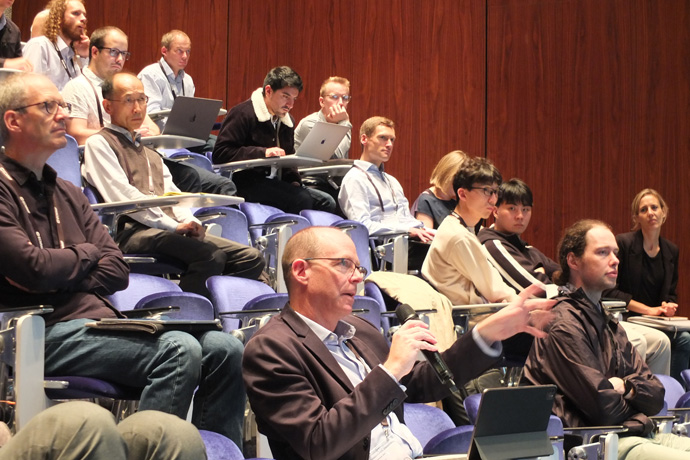
Members of the audience could ask questions or make comments during the Annual Seminar.
Physics matters
A shared conclusion of this seminar was that we should not only invest in ever higher model resolution and computational resources, but in physics developments in the forecast model and data assimilation. These become even more challenging at higher resolutions, while providing interesting and gratifying challenges for young researchers.
All presentations and recordings can be accessed on the Annual Seminar 2022 website.
